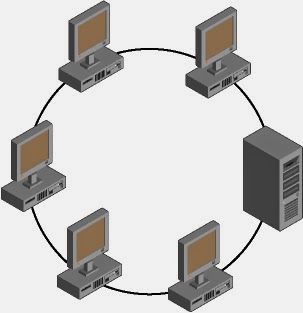OSI is the layer model for the network system designed by
ISO . OSI enable device to network to
communicate with each other.
Application Layer- The
Application Layer is the top most layer of the OSI model.
It provides network access to application and to users. The application layer to provide service with
which users can access all type of network
so application and user use these service to communicate with device and
remote application.
Service-
FTAM(File
Transfer and Management)-
Using the application user can access file in a remote host it
also enable the user manage file from remote host .
Mail
Deliver Box- Using
the application email can be forwarded to another computer “Massage Handling
Service” is the OSI protocol use for transfer mail over the internet.
Directory
Service- Directory service is a source of information. A about
such as people organization and file.
Network Virtual
Terminal- It is a
software version a physical terminal
version Terminal using user can log on
the computer. It is remotely
connected on the network.
Protocol
use in Application Layer-
TCP- A connection oriented protocol that is
defined at the transport layer of the OSI reference model provide reliable
delivery of data.
FTP- The TCP/IP protocol used for transmitting
files between network nodes . It
supports a brand range of file types and is defined in RFC959.
DHCP- DHCP is used automatically configured
a host during boot up on a TCP/IP network and also to change setting while the
host is attached.
This means
that you can stored all the available IP address in a central data base along
with information such as the subnet mask Gateways DNS server etc.
SMTP- A protocol used on the internet to
provide electronic mail Service.
DNS- DNS is used to convert user friendly
names to IP address. They are two Zones
in DNS.
Device-
No Device use.
Presentation Layer- The Presentation Layer is sixth form
the layer top the main function of this layer is the presentation of data. There are situations when data sent from one
system to another system has to be viewed in a different way. Translation is the main function of the
presentation layer the other function is rarely used.
Translation- In a network
there can be many type of computers, for example presentation layer is a mixed
systems, we have two different type of systems, in the same network. One is the MAC Machine and other is the UNIX
machine. Character set in both machine
is different, but the presentation layer hide the different.
Compression- This is an optional function,
but it can be done by the presentation layer to improve performance.
Encryption- We can use Presentation Layer
encryption function to ensure security SSL is the one of the popular
encryptions used in the Presentation layer.
Protocol-
RIP, SNMP AND DNS
Device- Gateway
Session Layer- It control the communication between
the hosts the session layer is responsible to establish on connection to the
user.
Service-
Dialog
Controller
Synchronization
Closing the Session
Dialog
Box- It allow to device
to enter into dialog controller these dialog can take place in there in half
duplex and full duplex.
Synchronization- If the
device is sending he file 100 pages to
ensure that these 100 pages without error they are greed link a sending data.
Closing the Session-
Ensure that the data transfer is completed before the session
closed.
Protocol- DNS, NETBIOS, SNTP, SMTP, FTP
Transport Layer- Transport layer is
responsible for source and the destination delivery the entire massage he
transport layer ensure that the entire massage he arrived the destination at
the computer.
Service-
Segmentation and Reassembling
Connection Control
Error Control
Segmentation and
Reassembling- A
Massage is delivered in to segment with each segment having a sequence
number when they arrived that the destination with a sequence number. The
transport layer Reassemble the massage.
Connection
Control- There are two
type of connection control.
Connection
Oriented
Connection Less
Error
Control- Two type of
Error Control.
Error Deduction
Error Correction
Protocol- TCP & UDP
Device- Gateway
Network
Layer- This is
responsible for routing and logical addressing.
A Network layer is provide service such as assigning IP address for the
delivering the packet.
Routing-
Routing is the selecting the best path for the packet.
Service-
Logical Addressing
Routing
Source of destination delivery
Logical Addressing- The data link
layer provide physical addressing which is useful of local Network When the
packet is forward a device out of a network be required other addressing
scheme o identify source and destination when we use 32 bit logical address.
Routing- Routing
is the process of where in a proper path define for the packet to reach
destination routing.
There are two type of routing.
Static Routing
Dynamic Routing
Static Routing-
In a static routing
he root o be forwarded by a packet its already sets by the network
administration.
Dynamic Routing- The
route to be forwarded by a packet is decided at time of transmission of the
packet.
Protocol-
IP
ARP
RARP
ICMP
Device- Router
Source & Destination delivery- Transfer
from the source to its destination delivery.
Data Link
Layer- It handle data
transfer between network layer and physical layer data unique data link layer
its called as frame.
Service-
Framing
Physical Addressing
Error Control
Exists Control
Flow Control
Protocol-
HDLC
SDLC
Device-
Bridge
Switch
Physical
Layer- It is
responsible to transmit up bit over the physical medium. A bi is a short of a binary digit, and is the
smallest unit of information on the computer.
The bit can be either 0 to 1.
Service-
Encoding
Transmission Rate
Transmission Mode
Note- No protocol working in Physical Layer.
Device- Router and Hub
Data Link
Layer For Ethernet- Ethernet
is data link layer responsible for physical source and destination addressing. The packet in to frame for transmitting the
network layer.











